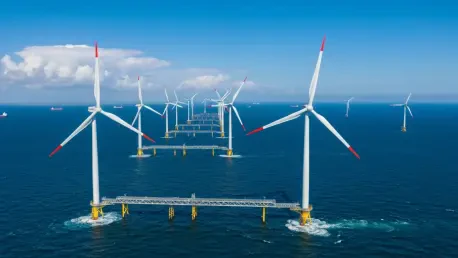As the European Union sets its sights on a transformative energy future, the goal of achieving at least 300 gigawatts (GW) of offshore wind capacity by mid-century stands as a monumental challenge and opportunity that could redefine the region’s energy landscape. This ambitious target, enshrined in the Offshore Renewable Energy Strategy and bolstered by initiatives like REPowerEU, underscores the urgency to transition to sustainable energy sources amid pressing climate concerns. Beyond the EU, North Sea countries have aligned with similar aspirations, amplifying the need for a coordinated push. Yet, with current grid connections representing only a fraction of the envisioned capacity, the path forward demands innovative strategies and unprecedented collaboration. Scaling up offshore wind energy is not merely a technical endeavor but a complex interplay of policy, planning, and societal acceptance. This article delves into the critical areas that must be addressed to bridge the gap between ambition and reality, exploring actionable solutions to ensure that offshore wind becomes a cornerstone of Europe’s renewable energy landscape.
Integrated Planning as the Foundation for Growth
The cornerstone of expanding offshore wind energy lies in integrated planning that transcends traditional sectoral boundaries. Effective development requires a seamless alignment of maritime, climate, energy, and transport strategies to create a cohesive framework. Such an approach necessitates close cooperation among diverse planning authorities across member states, ensuring that national energy and climate plans are synchronized under the broader governance of the Energy Union. Without this holistic perspective, fragmented efforts risk stalling progress and inflating costs. The complexity of balancing competing interests—such as shipping lanes and environmental conservation—demands a unified vision that prioritizes long-term sustainability over short-term gains. By embedding offshore wind projects within a wider strategic context, Europe can mitigate conflicts and optimize resource allocation, paving the way for scalable growth that supports both economic and ecological goals in the journey toward the 2050 targets.
Another critical aspect of integrated planning is its capacity to anticipate future challenges and adapt accordingly. As offshore wind projects expand into deeper waters and more remote locations, the need for forward-thinking policies becomes paramount. This involves not only mapping out spatial requirements but also aligning them with evolving technological capabilities and regulatory frameworks. Collaboration at the regional level, particularly among North Sea nations, can serve as a blueprint for sharing best practices and harmonizing standards. Such partnerships help in addressing transboundary issues, ensuring that development in one area does not inadvertently hinder progress elsewhere. Moreover, integrating climate resilience into planning ensures that infrastructure can withstand changing environmental conditions over the coming decades. This proactive stance is essential to safeguard investments and maintain momentum, reinforcing the role of integrated planning as a linchpin for achieving the ambitious offshore wind capacity goals set for the middle of the century.
Streamlining Permitting for Rapid Deployment
One of the most pressing bottlenecks in scaling up offshore wind energy is the cumbersome permitting process, particularly for cross-border and hybrid projects that combine energy production with interconnectors. Simplifying these procedures is vital to accelerate deployment while maintaining environmental and safety standards. Lengthy approval timelines often deter investment and delay critical infrastructure development, undermining the urgency of meeting renewable energy targets. A streamlined approach could involve standardized criteria across member states, reducing bureaucratic hurdles and fostering predictability for developers. Additionally, prioritizing projects that demonstrate significant regional benefits can help focus resources where they are most needed. By cutting down on red tape without compromising oversight, Europe can ensure that offshore wind initiatives move from concept to construction at a pace that matches the scale of the climate challenge ahead.
Beyond procedural efficiency, addressing permitting challenges also requires innovative regulatory mechanisms to support hybrid grid solutions. These projects, which integrate generation and transmission across borders, face unique legal and administrative obstacles due to differing national frameworks. Establishing a unified permitting pathway for such initiatives could unlock significant cost savings and environmental benefits by optimizing infrastructure use. Collaboration among regulatory bodies and transmission system operators is essential to align rules and expedite approvals. Furthermore, incorporating digital tools for application processing and stakeholder consultation can enhance transparency and speed. As the demand for offshore wind ramps up, ensuring that permitting keeps pace with technological and market developments will be crucial. This dual focus on efficiency and innovation in regulatory processes can help transform the current landscape, enabling Europe to build the necessary capacity to meet its mid-century renewable energy ambitions.
Advancing Grid Development for Connectivity
Grid development stands as a formidable barrier to realizing offshore wind potential, with current connections accounting for a mere fraction of the capacity needed by 2050. Transitioning from traditional national radial connections to more sophisticated multipurpose solutions, such as hybrid projects and energy hubs, is imperative for efficiency. These advanced systems allow for better integration of offshore wind into the broader energy network, reducing congestion and enhancing reliability. For instance, exploring priority corridors within frameworks like ENTSO-E can offer a model for interconnected systems that maximize output. Embracing offshore bidding zones over conventional home market approaches also promises to reflect physical energy flows more accurately, improving price formation and grid stability. Such a shift, however, demands regulatory alignment and high-level cooperation among stakeholders to ensure seamless implementation across borders.
Equally important is the need to address the financial and logistical hurdles associated with grid expansion for offshore wind. Anticipatory investments in infrastructure can prevent bottlenecks, but they require clear cost-benefit allocation models to distribute expenses equitably among nations. Delays in regulatory evolution must be avoided to maintain momentum, leveraging existing pathways for progress. Collaborative efforts among transmission system operators and policymakers can facilitate the adoption of innovative grid designs that accommodate future energy demands, including emerging sectors like hydrogen production. The focus should be on creating a flexible, future-proof grid architecture that not only connects current projects but also anticipates the scale of growth projected over the next few decades. By prioritizing these advancements, Europe can build a robust energy backbone that supports the massive expansion of offshore wind, ensuring that connectivity keeps pace with generation capacity in the long term.
Fostering Mutual Benefits and Local Acceptance
Promoting mutual and local benefits is a pivotal strategy for ensuring the sustainable growth of offshore wind energy across Europe. Balancing competing maritime interests, such as fishing and shipping, with energy development requires innovative coexistence models that prioritize shared gains. Incorporating non-pricing criteria into offshore wind auctions can further ensure that projects deliver tangible advantages to local communities, from job creation to infrastructure improvements. Recent updates to EU legislation, like the Renewable Energy Directive and the Net Zero Industry Act, reflect this emphasis on community benefits, embedding principles of fairness into policy. By aligning development with local needs, resistance to projects can be minimized, fostering a sense of ownership among stakeholders. This approach not only enhances social acceptance but also strengthens the political will to support ambitious renewable targets through to 2050.
In addition to local benefits, the broader mutual advantages of cross-border cooperation cannot be overlooked in the offshore wind sector. Collaborative projects that span multiple countries can optimize resource use and reduce overall costs, creating a win-win scenario for participating nations. Encouraging dialogue among diverse stakeholders—ranging from industry players to environmental groups—helps address concerns early and build consensus around development plans. Financial mechanisms, such as contracts for difference, can also play a role in de-risking investments and ensuring equitable profit distribution. As offshore wind projects grow in scale and complexity, embedding these mutual benefits into the fabric of planning and execution will be essential. This focus on shared prosperity can transform potential conflicts into opportunities for partnership, ensuring that the expansion of offshore wind energy contributes to both regional stability and local empowerment over the coming decades.
Building a Collaborative and Innovative Future
Looking back, the journey to scale up offshore wind energy in Europe revealed a landscape defined by both immense potential and intricate challenges. Integrated planning proved to be the bedrock of progress, uniting disparate sectors under a common vision for sustainable growth. Streamlined permitting processes emerged as a catalyst, cutting through delays to bring projects online faster. Grid development, once a glaring weak spot, saw transformative shifts with hybrid solutions and interconnected systems paving the way for better energy flow. Meanwhile, fostering mutual benefits ensured that local communities and regional partners alike reaped the rewards of this green transition. Reflecting on these efforts, it became clear that collaboration among member states stood as the linchpin, averting crises and driving innovation. As Europe moved forward, the focus shifted to sustaining this momentum through adaptive policies, continued investment in cutting-edge grid technologies, and deeper cross-border partnerships to secure a renewable energy future.









